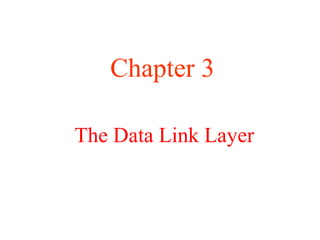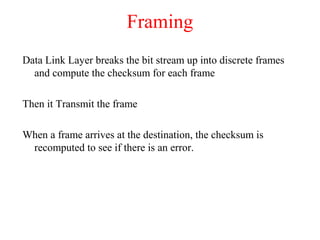R2 itesm-02
- 1. Chapter 3 The Data Link Layer
- 2. Data Link Layer Design Issues Algorithms for achieving reliable, efficient communication between two adjacent machines âĒ Services Provided to the Network Layer âĒ Framing âĒ Error Control âĒ Flow Control
- 3. Functions of the Data Link Layer âĒ Provide service interface to the network layer âĒ Dealing with transmission errors âĒ Regulating data flow âĒ Slow receivers not swamped by fast senders
- 4. Functions of the Data Link Layer (2) Relationship between packets and frames.
- 5. Services Provided to Network Layer (a) Virtual communication. (b) Actual communication.
- 6. Services Provided to Network Layer (2) Placement of the data link protocol.
- 7. Framing Data Link Layer breaks the bit stream up into discrete frames and compute the checksum for each frame Then it Transmit the frame When a frame arrives at the destination, the checksum is recomputed to see if there is an error.
- 8. Framing ï Breaking up the bits to make frames â Insert time gaps (networks rarely make any guarantees about timing) â Character count â Flag bytes with byte stuffing â Starting and ending flags, with bit stuffing â Physical Layer coding violations
- 9. Framing A character stream. (a) Without errors. (b) With one error.
- 10. Framing (2) (a) A frame delimited by flag bytes. (b) Four examples of byte sequences before and after stuffing.
- 11. Framing (3) Bit stuffing (a) The original data. (b) The data as they appear on the line. (c) The data as they are stored in receiverâs memory after destuffing.
- 12. Flow control What to do with a sender that systematically wants to transmit frames faster than the receiver can accept them a) Feedback-based flow control â receiver sends back information to the sender giving it permission to send more data a) Rate-based flow control (never used in data-link layer) â protocol has a built-in mechanism that limits the rate at which senders may transmit data, without using feedback from the receiver
- 13. Elementary Data Link Protocols âĒ An Unrestricted Simplex Protocol âĒ A Simplex Stop-and-Wait Protocol âĒ A Simplex Protocol for a Noisy Channel
- 14. Protocol Definitions Continued ï Some definitions needed in the protocols to follow. These are located in the file protocol.h.
- 15. Protocol Definitions (ctd.) Some definitions needed in the protocols to follow. These are located in the file protocol.h.
- 17. Simplex Stop-and- Wait Protocol
- 18. A Simplex Protocol for a Noisy Channel A positive acknowledgement with retransmission protocol. Continued ï
- 19. A Simplex Protocol for a Noisy Channel (ctd.) A positive acknowledgement with retransmission protocol.



















